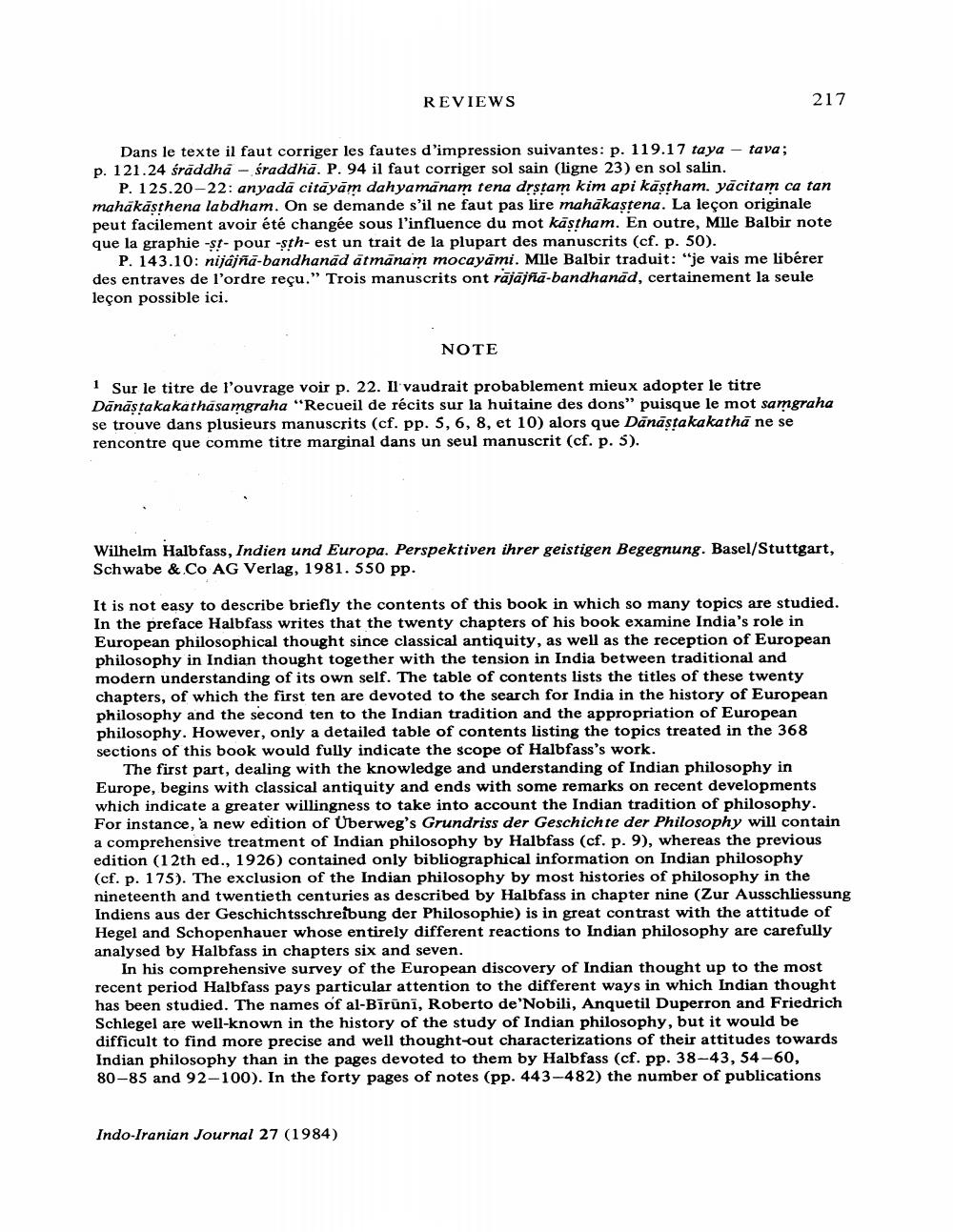Book Title: Book Reviews Author(s): J W De Jong Publisher: J W De Jong View full book textPage 7
________________ REVIEWS 217 Dans le texte il faut corriger les fautes d'impression suivantes: p. 119.17 taya - tava; p. 121.24 śrāddha - śraddha. P. 94 il faut corriger sol sain (ligne 23) en sol salin. P. 125.20-22: anyadā citāyām dahyamanam tena drstam kim api kästham. yācitam ca tan mahākāsthena labdham. On se demande s'il ne faut pas lire mahākastena. La leçon originale peut facilement avoir été changée sous l'influence du mot kästham. En outre, Mlle Balbir note que la graphie -st-pour-sth- est un trait de la plupart des manuscrits (cf. p. 50). P. 143.10: nijájñā-bandhanad ātmānam mocayāmi. Mlle Balbir traduit: "je vais me libérer des entraves de l'ordre reçu." Trois manuscrits ont rajajna-bandhanäd, certainement la seule leçon possible ici. NOTE 1 Sur le titre de l'ouvrage voir p. 22. Il vaudrait probablement mieux adopter le titre Dānāstakakathasamgraha "Recueil de récits sur la huitaine des dons" puisque le mot samgraha se trouve dans plusieurs manuscrits (cf. pp. 5, 6, 8, et 10) alors que Dānästakakathā ne se rencontre que comme titre marginal dans un seul manuscrit (cf. p. 5). Wilhelm Halbfass, Indien und Europa. Perspektiven ihrer geistigen Begegnung. Basel/Stuttgart, Schwabe & Co AG Verlag, 1981.550 pp. It is not easy to describe briefly the contents of this book in which so many topics are studied. In the preface Halbfass writes that the twenty chapters of his book examine India's role in European philosophical thought since classical antiquity, as well as the reception of European philosophy in Indian thought together with the tension in India between traditional and modern understanding of its own self. The table of contents lists the titles of these twenty chapters, of which the first ten are devoted to the search for India in the history of European philosophy and the second ten to the Indian tradition and the appropriation of European philosophy. However, only a detailed table of contents listing the topics treated in the 368 sections of this book would fully indicate the scope of Halbfass's work. The first part, dealing with the knowledge and understanding of Indian philosophy in Europe, begins with classical antiquity and ends with some remarks on recent developments which indicate a greater willingness to take into account the Indian tradition of philosophy. For instance, a new edition of Überweg's Grundriss der Geschichte der Philosophy will contain a comprehensive treatment of Indian philosophy by Halbfass (cf. p. 9), whereas the previous edition (12th ed., 1926) contained only bibliographical information on Indian philosophy (cf. p. 175). The exclusion of the Indian philosophy by most histories of philosophy in the nineteenth and twentieth centuries as described by Halbfass in chapter nine (Zur Ausschliessung Indiens aus der Geschichtsschreibung der Philosophie) is in great contrast with the attitude of Hegel and Schopenhauer whose entirely different reactions to Indian philosophy are carefully analysed by Halbfass in chapters six and seven. In his comprehensive survey of the European discovery of Indian thought up to the most recent period Halbfass pays particular attention to the different ways in which Indian thought has been studied. The names of al-Birunī, Roberto de Nobili, Anquetil Duperron and Friedrich Schlegel are well-known in the history of the study of Indian philosophy, but it would be difficult to find more precise and well thought-out characterizations of their attitudes towards Indian philosophy than in the pages devoted to them by Halbfass (cf. pp. 38-43, 54-60, 80-85 and 92-100). In the forty pages of notes (pp. 443-482) the number of publications Indo-Iranian Journal 27 (1984)Page Navigation
1 ... 5 6 7 8 9 10 11 12 13 14 15 16 17 18 19 20 21 22
